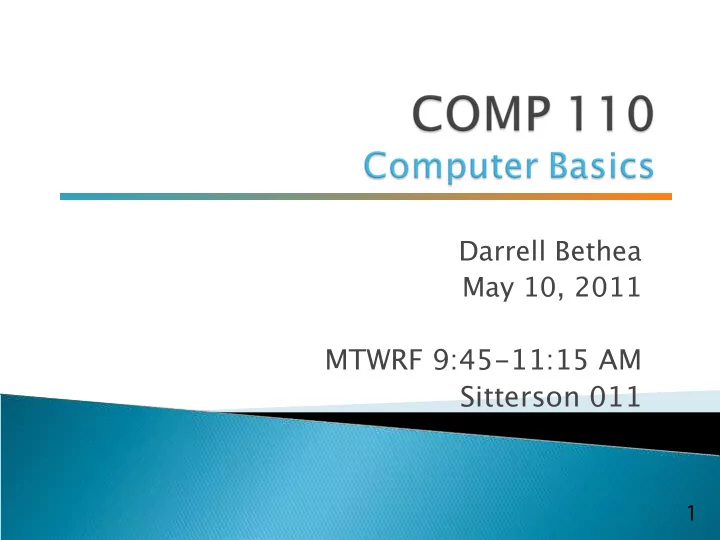

Darrell Bethea May 10, 2011 MTWRF 9:45-11:15 AM Sitterson 011 1
O ffj ce hours: MW 1-2 PM If you still cannot make it to either o ffj ce hour, email me to set up an appointment if you need help with an assignment.
Hardware and Memory Programs and Compiling Your first program
Need to know basics of a computer ◦ If you want to cook, you should know basic ingredients and understand how food is prepared. Understand what your program is doing Talk intelligently about computers 5
Hardware - physical machine ◦ CPU, Memory Software - programs that give instructions to the computer ◦ Windows XP, Google Chrome, Games, Eclipse 6
CPU (Central Processing Unit) - the “Brain” ◦ GHz Number of billions of instructions per second I.e, how fast the computer is ◦ Dual Core - multiple processing units per CPU 7
Holds data for the computer How much the “Brain” can remember Main Memory ◦ Memory computer uses for intermediate calculations (program you are running) ◦ Disappears when you shut down your computer Secondary Memory ◦ Disk drives, CDs, Flash drives ◦ Exists until you delete it 8
Your main memory 2 gigabytes of RAM ◦ (Meter - unit of distance) ◦ Bytes - unit of data ◦ Kilobyte = 1 thousand bytes ◦ Megabyte = 1 million bytes ◦ Gigabyte = 1 billion bytes 9
Smallest addressable unit of memory Both main memory and auxiliary memory are measured in bits 1 byte = 8 bits Bit = 0 or 1 (on or o fg ) Language of the computer is bits 0 0 1 1 1 0 1 0 - 1 byte of 8 bits 10
Set of instructions for a CPU to follow Also known as software. You will be writing programs ◦ We will look at one soon Hard for humans to write bits directly 11
High-level language Your Program (human readable) Compiler Low-level language Machine Language (Bits) (computer readable) 12
What are the two kinds of memory in a computer? What is software? What is the di fg erence between a machine- language program and a high-level language program? 13
import java.util.*; public class FirstProgram { public static void main(String[] args) { System.out.println("Hello out there."); System.out.println("I will add two number for you."); System.out.println("Enter two whole numbers on a line:"); int n1, n2; Scanner keyboard = new Scanner(System.in); n1 = keyboard.nextInt(); n2 = keyboard.nextInt(); System.out.println("The sum of those two numbers is"); System.out.println(n1 + n2); } } 14
import java.util.*; Package = Library of classes Java.util is a package Different libraries give different information Physics Library = Newtonian Physics Music Library = your iTunes collection java.util. = Allows you to read data from keyboard 15
Begin the Program public class FirstProgram { public static void main(String[] args) { Begin a program named FirstProgram Program names should make sense Another name for this program could be AddTwoNumbers You should always capitalize the first letter of each word in your program name 16
System.out.println("Hello out there."); System.out.println("I will add two numbers for you."); System.out.println("Enter two whole numbers on a line:"); Write what is in quotes to screen 17
Class - Category of Objects ◦ E.g., Stapler Object - A specific member of that category ◦ E.g., My red Swingline Method - Actions performed by objects ◦ E.g., Staple pages, load staples, fix jam, etc. 18
myRedSwingLine.fixJam(); ramses.eatGrass(); Method Object System.out.println(“Hi”); Invoke Method 19
int n1, n2; Variable - store piece of data n1 - store integer n2 - store integer 20
Scanner keyboard = new Scanner(System.in); Class Object Not always System.in Create object (keyboard) of Scanner class Stapler myRedSwingLine = new Stapler(); 21
Method Object n1 = keyboard.nextInt(); Invoke/Call Read an integer from the keyboard and store it in n1 22
System.out.println("The sum of those two numbers is"): System.out.println(n1 + n2); Add n1 and n2 Print the sum to the screen 23
import java.util.*; public class FirstProgram { public static void main(String[] args) { System.out.println("Hello out there."); System.out.println("I will add two number for you."); System.out.println("Enter two whole numbers on a line:"); int n1, n2; Scanner keyboard = new Scanner(System.in); n1 = keyboard.nextInt(); n2 = keyboard.nextInt(); System.out.println("The sum of those two numbers is"); System.out.println(n1 + n2); } } 24
Hello out there. I will add two numbers for you. Enter two whole numbers on a line: 12 30 Input by user The sum of those two numbers is 42
Before Tomorrow Eclipse Your first java program Download and Install Eclipse before lab (see webpage) Go through the Eclipse Tutorial on your own Get the textbook! Read 1.1-1.3
Recommend
More recommend